1. Project and mainstream market analysis
1.1 Project Analysis
Naked-eye 3D has hit all the major social platforms. With the widespread application of digital visual products in the market, a series of magical art buildings in modern cities have become popular all over the Internet.
These “art + technology” projects with naked-eye 3D special effects have become the city’s new internet celebrity business card.
Attracting tourists to stop and attract top traffic to create momentum, naked-eye 3D outdoor LED large screens can achieve advantages that traditional advertising media cannot achieve!
Special CG animation materials + ultra-clear LED screen + real 3D sound effects
The 3D sci-fi large LED screen actually uses the following principles, equipment and technologies to create a digital project that allows you to experience 3D images with the naked eye without wearing viewing equipment.
Utilize the following technologies to realize a high-tech LED large screen, play special CG animations, and achieve a new technological art screen.
A. 8K ultra-high definition + special 3D material + curved right-angle display (indoor 3D pillar screen display)
B. Small spacing screen + high refresh rate + seamless splicing
1.2 Small spacing indoor and outdoor LED screens
Generally speaking, to produce this kind of naked-eye 3D display with a strong sense of technology, we use LED displays ≤P2.5 for indoors, and P2.5-P3 LED screens for outdoor.
Small-pitch LED displays have performance advantages such as seams, color, uniformity, and power consumption.
As a representative of new light sources, small-pitch LED displays not only have the inherent seamless advantage, but also have excellent brightness and color advantages, as well as low energy consumption and ultra-long service life.
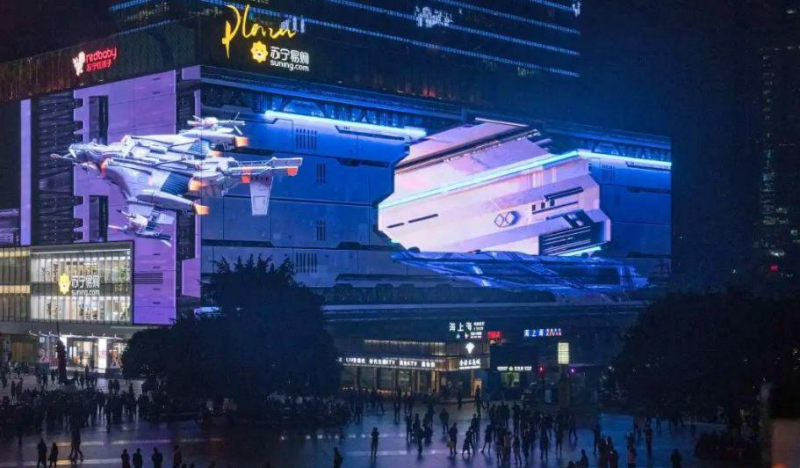
1.3 3840Hz high refresh indoor and outdoor LED screen
The refresh rate refers to the number of times the electron beam repeatedly scans the image on the screen.
The higher the number of scans, the higher the refresh rate, and the better the stability of the displayed image (screen).
The lower the refresh rate, the more the image will flicker and jitter, and the faster your eyes will tire.
Under high refresh rate, the LED small-pitch screen captures stable images, without ripples on the black screen, and the image edges are clear, accurately restoring the true information of the image.
The refresh rate reaches 3840Hz, and the camera captures stable images, which can effectively solve the smearing and blurring during rapid image movement, enhance the clarity and contrast of the image, make the video picture delicate and smooth, and make it less likely to be fatigued after long-term viewing.
With anti-gamma correction technology and point-by-point brightness correction technology to make the dynamic picture display more realistic, natural, unified and consistent.
1.4 Seamless splicing
Seamless splicing technology makes the images displayed on the 3D LED screen more integrated and not obtrusive at all.
At the same time, the curved right-angle display technology makes the screen more 3D and the image more realistic.
1.5 3D CG animation
Creative customized 3D animation is one of the core elements of the new naked-eye 3D business card.
LED screens are increasingly used in China, especially in first- and second-tier cities, where they can be seen almost everywhere. Creative thinking and artistic techniques are the soul.
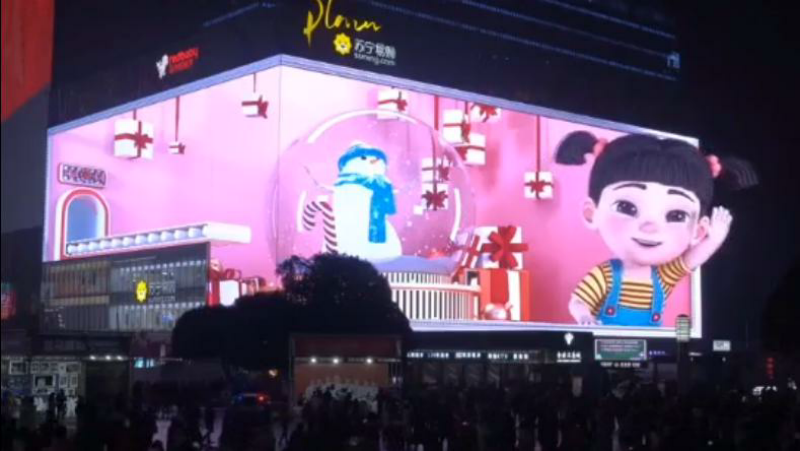
1.6 Curved surface right-angle display (3d led display)
Chongqing’s naked-eye 3D Internet celebrity LED large screen adopts a curved right-angle display method.
As shown in the figure, at right angles to the curved surface, you can view it with the naked eye and even shoot and collect magical 3D images.
This is an advantage that traditional LED screens cannot meet.
Through creative artistic methods, our company makes the LED large screen not only have a naked-eye 3D feeling, but also a very strong sense of beauty and art.
Naked-eye 3D LED large screen, business cards of contemporary new Internet celebrities have become unstoppable.
New landmarks in the city are coming, naked-eye 3D LED large screens, the king of the times, digital vision takes the lead!
2. Analysis of 3D led display visual content technology
2.1 Classification of 3D content design
3D special effects technology can generally be divided into two directions, namely two-dimensional and three-dimensional.
The more traditional animation used to be two-dimensional animation, also often called 2D animation, which is produced using two-dimensional effects.
The important design method is hand-drawing. The designed picture effect is a continuous plane effect, and the scenery is mostly rendered with ink.
The effect presented by the character or animal design is just like the familiar image effects of Donald Duck and Tom Cat to the audience.
Three-dimensional animation is often called 3D animation because it adopts a three-dimensional space concept, which is essentially different from 2D animation design.
Based on three-dimensional image technology, three-dimensional animation constructed using three-dimensional animation software has strong freedom in spatial conception and outstanding creativity.
It can make the picture more textured and real, thereby also bringing the audience a Comes with a strong attraction. Currently, in the field of animation design, three-dimensional animation is the most popular.
In addition, in animation design, 3D animation is composed of procedures such as description of object image, 3D modeling, material supplement, locked skeletal animation, rendering output, etc. The production process of such procedures is more laborious and complicated than 2D animation.
Not only must you be familiar with the use of 3D animation software, but you must also have good art design and art appreciation abilities.
The entire design process is produced through professional software such as Houdini, 3Dmax, Maya, shake, etc. The resulting scenery is extremely flexible and has a beautiful painting style.
Realistic and can simulate real-life objects. The effects of characters and animals are such as Shrek and Elf, which are well-known to the audience.
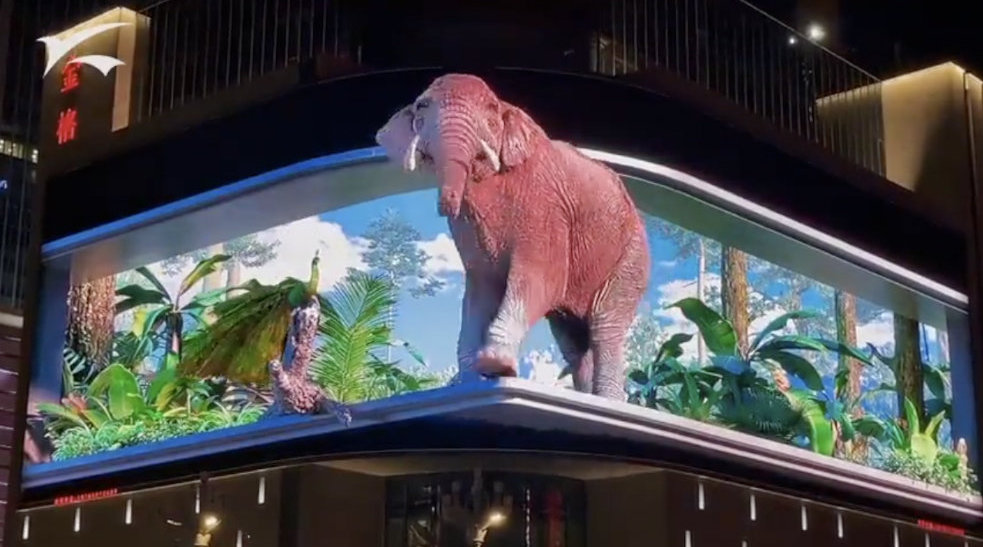
2.2 The meaning of special effects technology
Special effects technology is a type of rendering technology that relies on overall light effects.
With the continuous updating of the world’s animation design technology, many three-dimensional animations have appeared on the silver screen, and many excellent three-dimensional animation designs have been transformed into animated films, which are deeply loved by the audience.
Generally speaking, the special effects technology of animation uses human visual virtual images to create a special atmosphere in the animation environment or the special effects of the animation itself.
Such illusions can break the concepts of space, time and region, and bring good effects to the audience. visual experience.
However, the principle of using special effects technology in animation design is to ensure the vivid texture of the picture.
Three-dimensional animation design, such as “The Moon in the Qin Dynasty”, uses computer 3D special effects technology to transform flat characters into 3D animation effects, making the characters more vivid.
2.3 Application steps of 3D LED display special effects technology
Preliminary work of design
The preliminary work of three-dimensional animation includes the animation structure planning that needs to be formulated at the beginning of animation design, such as the split shots and related annotations of the manuscript, the animation environment structure, etc.
Its main task is to use words to describe the effects that need to be presented in the animation.
In the early stage of animation design, animation designers need to record and describe the character’s image and clothing matching in detail according to the preferences and personality characteristics of the protagonist and supporting characters in the animation.
This can facilitate the mastering of character configuration in animation design.
For example, the preliminary design requirements for our company to participate in the production of the three-dimensional animation “Bear Bears” require that the design of the animated scenery environment, the lighting arrangement of the animated pictures, and the modeling of various scenes should be summarized in order to be used for the production.
The use of post-production special effects technology.

2.4 Preliminary work of 3D LED display design
When the preliminary work of animation design goes smoothly, the remaining clips can be processed according to the planning annotations.
The processing of fragments requires the use of professional 3D operating software.
Especially with the significant development of computer technology, video design software has become more comprehensive and innovative.
During this period, video design uses more 3D design software, including 3Dmax, Maya, shake and Paint3D.
Among them, the more commonly used ones are Maya and shake, which are not only simple to operate, flexible and fast to use, but also have good rotation and graphics expandability.
By using this kind of animation design software, the work can be presented more realistically, giving people an immersive feeling.
In addition, architectural models are generally produced in design software. This is because the picture has many requirements for lighting.
Not only must you have good art appreciation skills, but you must also have certain software special effects technical capabilities, so as to ensure the stability and smoothness of the picture.
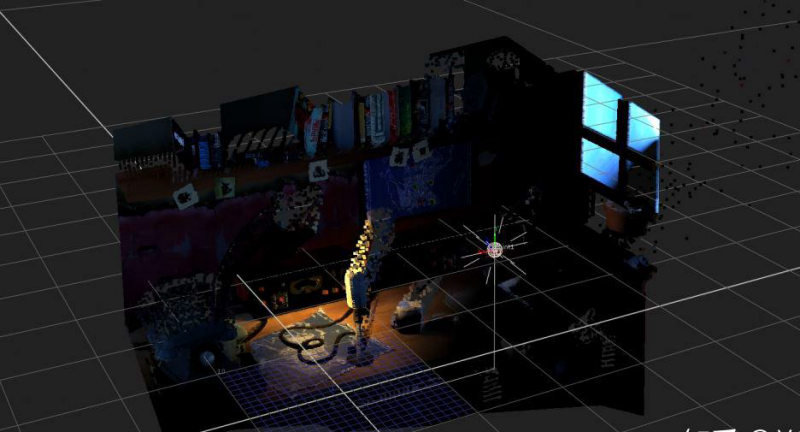
2.5 3D LED DISPLAYS final synthesis
The final synthesis of the animation is mainly about adding, connecting and combining the sound effects in the animation scene and the different animation parts produced after the preliminary work and processing of the animation fragments.
Use editing tools to ultimately produce a more robust dynamic animation. The characters in this part are the most critical.
At present, the commonly used compositing software is Nuke. Because of its innovative design program and perfect usage mode, it can combine various frame rates and present various styles.
special effects. Although animation design does not seem very complicated, it requires a lot of professional knowledge and familiarity with the use of Nuke.
Only in this way can the images be effectively connected and ultimately form various animations that will be loved on the screen.
This also shows that post-production special effects synthesis is very important in animation design.

3. Expressive power of 3D LED SCREENS special effects technology
3.1 Lens adjustment
The first is lens deployment, which mainly means that any tiny lens in animation design must have special technical effects to complete the integration of animation art.
Because the entire part of the animation is spliced together by many shots, if you want to successfully connect these tiny shots, you must use special effects techniques flexibly to make the rendering smoother and more harmonious.
Therefore, in some animated films, it is necessary to use virtual photography technology and virtual space texture to implement special effects technology operations to make the animation more vivid.
In the process of animation design, the use of 3D special effects technology can transform difficult action effects in reality through professional software and sensitive sensors, thus making the audience feel the best artistic effect of animation.
3.2 Special effects light and shadow
Second is special effects light and shadow. The most widely used and popular special effects technology is special effects light and shadow technology.
In traditional animation design, the light and shadow effects are very roughly adjusted according to the description of the original animation.
This kind of processing method is often used in traditional animation, but it is not introduced by most designers in existing animation design.
This is mainly because This is because the dimming technology will make the animated scene lack of flexibility and realism.
Therefore, in contemporary animation design, designers are more inclined to use special effects light and shadow, which is achieved through special effects light and shadow technology, so that the protagonist’s feelings and situations can be well presented to the audience.
This special effect can be created by using the key frame technology of special 3D animation design software to complete the particle offset operation where the scene and characters reflect each other.
In addition, through the use of special effects technology, the characteristic index of virtual light and shadow can be changed to complete the radiant effect of light and shadow.
3.3 Crossover effects
Then there is the cross-effects technology. The operation of this type of special effects technology can be achieved through the construction of animation models, and the cross-effects technology can be used to realize the walking paths of animated characters or other objects, thereby creating a good simulation scenario.
The definition and the still life on both sides are used to complete the interactive coordination of the overall painting style, thereby driving the still life on both sides of the road to change as the objects walk.
In addition, the character image must be designed to resonate and interact with the audience.
By using simulation technology to complete distinctive visual effects in animation design, this type of cross-effects technology has good development potential in future animation design.
3.4 Three-dimensional texture
Finally, there is the three-dimensional texture. By using the three-dimensional texture special effects technology, it can not only set off the animated characters well, but also use the perspective of 3D space to make the picture present dynamic special effects, thereby promoting the good integration of the objects in the animation with the surrounding environment.
In the case of traditional animation design, the animation situation and the created animation objects are no longer produced together, but are stored separately in the state of the elements.
In traditional animation space design, the setting of objects in animation is often combined with blank space for creation, but if 3D three-dimensional texture is used, objects in animation can be transformed in all directions.
3.5 Basic naked-eye 3D display principle (imaging of reverse perspective projection)
The basic perspective projection model consists of two parts: the viewpoint E and the viewing plane P (requiring that E is not on the plane P).
The viewpoint can be thought of as the observer’s position and the angle from which the three-dimensional world is observed.
The view plane is the two-dimensional plane that renders the perspective of a three-dimensional object. As shown in Figure 1.
For any point X in the world, construct a ray R starting from E and passing through point X. The intersection Xp of R and plane P is the perspective projection result of point X.
Objects in the three-dimensional world can be seen as consisting of point sets Xi. In this way, rays Ri starting from E and passing through point Xi are constructed in sequence.
The intersection set of these rays and the visual plane P is the perspective view of the three-dimensional world at the current viewpoint. As shown in Figure 2.

Figure 1 Basic model of perspective projection Figure 2 Perspective imaging principle
The basic perspective projection model has no restrictions on the position of the viewpoint E and the size of the viewing plane P, as long as the viewpoint is not on the viewing plane.
P infinity is only applicable to theoretical analysis. The actual situation always limits P to a rectangular plane of a certain size, and the perspective results located outside P will be clipped.
You can imagine that the viewing plane is a transparent glass window, and the viewpoint is the observer in front of the glass window.
The external world seen by the observer through the glass window is equivalent to the perspective projection of the external world on the glass window (it always feels not very appropriate, But can’t think of a better metaphor).
When the size of P is limited, the visual interval (or visual volume) of viewpoint E degenerates into a pyramid, as shown in Figure 3.
The pyramid is still an infinite area, where the viewpoint E is the vertex of the pyramid and the viewing plane P is the cross section of the pyramid.
In practical applications, the prism located in the middle of the two cross-sections is often taken as the visible area (as shown in Figure 4).
Objects completely outside the prism will be eliminated, and objects located at the edge of the prism will be clipped.
The frustum is also called the viewing frustum, which is a projection model often used in computer graphics.
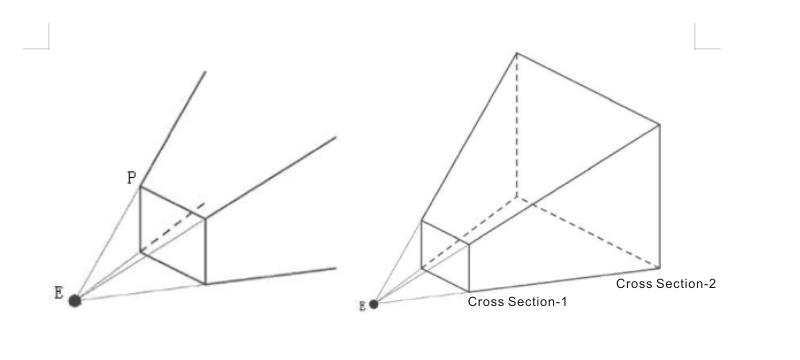
Figure 3 Visual interval of limited viewing plane Figure 4 Viewing frustum model of perspective projection
The rendered projection picture we see from a specific angle is the same as a real object placed in the environment, visually causing the brain to create an illusion to achieve a naked-eye 3D effect.




